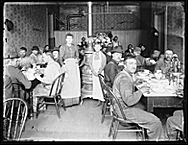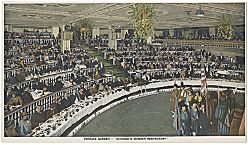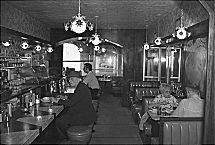| Entries |
| R |
|
Restaurants
|

|
Because dining enterprises mirror the city's economic growth, their histories might be considered in two ways, “pull and push.” Restaurants represent the centripetal forces that made the city the economic hub of the Midwest. Chicago's famed steakhouses testified to its hegemony in cattle shipping and meat processing. The city's historical core business area, the Loop, has been an “economic catchment” center. Visitors to the Midwest's capital city and the necessity of feeding incoming hordes of workers made Chicago's eating places elements of a major industry. By 2000, the Chicago area's dining establishments did an estimated $10 billion in sales, second among U.S. metropolitan areas only to Los Angeles.

|
City shoppers and workers who packed downtown offices led to a boom in eating places. “Cheap Eats” restaurants first appeared in the 1880s, and many upscale restaurants and hotels served inexpensive lunches. Beginning in 1880 with H. H. Kohlsaat's “dairy lunch room,” quick-service restaurants for midday meals sprang up. John Kruger began a small chain in the 1890s, dubbing them “Cafeterias.” Soon, major chains such as Thompson's (with more than one hundred outlets), B/G Foods, Pixley & Ehlers, and many others were so numerous that the area around Madison and Clark Streets became known as “Toothpick Alley.” Through proximity to work and shopping, city restaurants became magnets for urban populations.
Food stands and street vendors fall into the category of “petty consumption.” Though important parts of the food economy, as cash businesses they are often underreported and hence an aspect of underground economy. Stands selling one of Chicago's paradigmatic foods, hot dogs, dot the city: an estimated 3,000 in present-day Chicago. None of the places are destination dining spots, but they are significant economic players by sheer numbers alone. By the end of the 1990s, the major purveyor of hot dogs in Chicago, the Vienna Sausage Manufacturing Company, was a business with some $98 million in annual sales. Neighborhoods into which immigrants moved and did business became identified with ethnic restaurants, particularly with fast-food (hot dog) stands.

|
Fast food and cafeterias were not the only restaurant innovations that became national trends. Fred Mann opened a Chicago seafood restaurant in 1923 with a maritime decor that include fishnets, portholes, and waitresses dressed as sailors. An instant hit, other “theme” restaurants quickly sprang up across the country. The pattern was updated in the 1970s when Richard Melman and partners opened a series of casual dining restaurants in the Chicago area beginning with R. J. Grunts in 1971. The idea was quickly copied by national chains. By the end of the century, the company Melman founded, Lettuce Entertain You Enterprises, Inc., owned or licensed 70 restaurants across the United States and Japan. Like McDonald's, this and other dining enterprises have extended outward, thus enriching Chicago's economy and its reputation for dining.
The Encyclopedia of Chicago © 2004 The Newberry Library. All Rights Reserved. Portions are copyrighted by other institutions and individuals. Additional information on copyright and permissions.